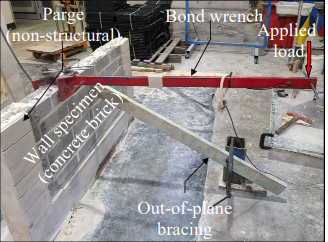Lewis J. Gooch, Chee Yin Lam, Lyndsey G. Terry, Mark J. Masia, and Mark G. Stewart
i Research Associate, The University of Newcastle, Callaghan, Australia, & University of Technology Sydney, Ultimo, Australia, lewis.gooch@newcastle.edu.au
ii Ph.D. Student, The University of Newcastle, Callaghan, Australia, cheeyin.lam@uon.edu.au
iii Ph.D. Student, The University of Newcastle, Callaghan, Australia, lyndsey.terry@uon.edu.au
iv Professor, The University of Newcastle, Callaghan, Australia, mark.masia@newcastle.edu.au
v Distinguished Professor, University of Technology Sydney, Ultimo, Australia, mark.stewart@uts.edu.au
ABSTRACT
The flexural tensile bond strength of masonry is critical to defining the out-of-plane bending resistance of unreinforced and ungrouted masonry walls (URM). This is particularly relevant to concrete URM which is often utilised in the construction of retaining walls, load-bearing internal wythes of masonry cavity wall construction, and other structural elements typically subject to out-of-plane loading. Due to its dependence on workmanship, mortar quality and brick/block typology, the flexural tensile bond strength of masonry has been observed to be highly variable. Furthermore, previous investigations of the spatial variability of clay brick masonry indicate that the sequential nature of construction for masonry walls often introduces a correlation between the properties of adjacent mortar joints. Understanding this spatial variability will improve the accuracy of probabilistic models of URM and is an important consideration in a structural reliability-based analysis of URM performance. The current study presents a laboratory investigation in which three concrete masonry walls – two concrete block and one concrete brick – were sequentially deconstructed using the bond wrench test method. From this testing, the spatial variability of the flexural tensile bond strength of each wall specimen has been quantified. Furthermore, the spatial variability of mortar joint thicknesses has also been analysed to quantify the correlation between adjacent joint thicknesses, as well as to assess any relationship between the thickness and strength of individual mortar joints.
KEYWORDS: concrete block, concrete brick, flexural tensile strength, spatial variability, ungrouted, unreinforced.
019-Gooch.pdf



